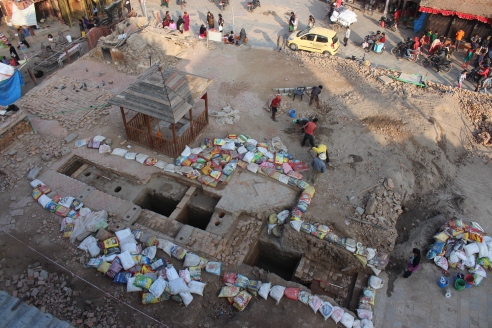Between the 5th October and the 22nd November 2015, national experts from the Department of Archaeology, Government of Nepal, in collaboration with archaeologists from Durham University, began a series of archaeological investigations in the three earthquake damaged Durbar Squares of Hanuman Dhoka, Patan, and Bhaktapur within the UNESCO Kathmandu Valley World Heritage Site.
At each square, the team combined the use of Ground Penetrating Radar (GPR) and excavation trenches to map the location of subsurface archaeological features and explore the state of the foundations of key damaged monuments in order to inform engineers and architects tasked with the construction of new foundations for the collapsed monuments.
The results showed that in many cases the foundations were resilient and undamaged by the 2015 earthquakes or previous seismic events, and the collapse of many monuments may be linked to superstructure maintenance issues. The team concluded by recognising that plans to swiftly reconstruct temples of existing ruined platforms will first need detailed recordings and scientific analysis of their foundations as few archaeological studies of Kathmandu’s monuments have considered them.

“For the first time, archaeological investigations have been pivotal in the aftermath of a natural disaster, illustrating the role that archaeology can play in guiding post-disaster responses to reconstruction and rehabilitation of earthquake damaged heritage. Our pilot investigations have illustrated the dynamic histories and developments of the three Durbar Squares, as well as providing information that will aid the sympathetic reconstruction of collapsed and damaged monuments whilst protecting subsurface archaeological heritage”.
The archaeological work was undertaken jointly by the Department of Archaeology, Government of Nepal and Durham University and Stirling University, with financial support from UNESCO. The rescue excavations and archaeological investigations are part of the remit of the UNESCO Chair in Archaeological Ethics and Practice in Cultural Heritage, at Durham University, to develop debates, policies and methodologies to evaluate the economic, ethical and social impacts of cultural heritage, and particular to strengthen the protection of heritage in crisis situations.
To read more about last year’s post-earthquake archaeological investigations in Kathmandu, visit: https://www.dur.ac.uk/cech/unescochair/research/kathmandu/

